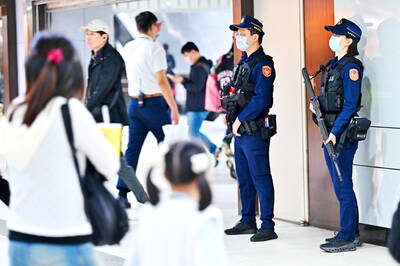The Council of Labor Affairs (CLA) is facing a boycott by labor groups over its "flexitime" policy, a practice which allows employers to utilize man-hours more economically, but which could also mean more stress and less pay for workers.
While yesterday marked the third month since CLA Chairman Chen Chu (
The Executive Yuan announced in mid-June that it had successfully brokered a consensus between labor groups and industry representatives to have the workweek reduced to 44 hours.
However, on the same day the KMT came up with a proposal to reduce working hours to 84 hours every two weeks. The proposal was successfully pushed through the legislature on June 17.
Industries have protested the change and vigorously lobbied to have the amendment overturned, or to at least be allowed the flexibility to arrange man-hours according to production cycles.
Such an arrangement would allow employers to concentrate work time without breaking the fortnight limitation in cases where they have to rush to meet production deadlines.
In view of strong protests from industrial leaders, the CLA is seeking adjustments that would allow this flexibility without infringing on labor rights. However, it appears little progress will be made as industry and labor groups are apparently far apart over the issue.
The nation's employers say that productivity will suffer serious setbacks when weekly working hours are reduced on Jan. 1 next year. They urged the government to propose modifications to "flexitime" legislation as a way for employers to more economically utilize the diminished man-hours.
But labor groups have condemned the flexitime proposal. They say the measures would allow employers to enforce extended working hours, which could put laborers under extreme stress and deprive them of overtime pay during extended shifts.
The CLA has scheduled three public hearings on the workweek issue, the first on Aug. 30, followed by others on Sept. 4 and Sept. 7.
Chen originally expected that the meetings would be attended by industry and labor leaders, but labor groups yesterday refused Chen's invitations, saying they feel the CLA has tilted its support in favor of employers.
"We oppose any form of conference that the government holds under pressure from the employers. And it's impossible for us labor groups to take part in the CLA's public hearings with preconditions having been laid," said Lin Hui-kuan (
With the boycott by labor groups, Chen decided yesterday to cancel the first public hearing. But she said she will continue to negotiate with the labor groups about their participation in the other two.
At a press conference, Chen mapped out the CLA's plans for the future, which include raising the quality of manpower, ensuring safe working environments and improving the well-being of laborers.

The US government has signed defense cooperation agreements with Japan and the Philippines to boost the deterrence capabilities of countries in the first island chain, a report by the National Security Bureau (NSB) showed. The main countries on the first island chain include the two nations and Taiwan. The bureau is to present the report at a meeting of the legislature’s Foreign Affairs and National Defense Committee tomorrow. The US military has deployed Typhon missile systems to Japan’s Yamaguchi Prefecture and Zambales province in the Philippines during their joint military exercises. It has also installed NMESIS anti-ship systems in Japan’s Okinawa

TRAGEDY STRIKES TAIPEI: The suspect died after falling off a building after he threw smoke grenades into Taipei Main Station and went on a killing spree in Zhongshan A 27-year-old suspect allegedly threw smoke grenades in Taipei Main Station and then proceeded to Zhongshan MRT Station in a random killing spree that resulted in the death of the suspect and two other civilians, and seven injured, including one in critical condition, as of press time last night. The suspect, identified as a man surnamed Chang Wen (張文), allegedly began the attack at Taipei Main Station, the Taipei Fire Department said, adding that it received a report at 5:24pm that smoke grenades had been thrown in the station. One man in his 50s was rushed to hospital after a cardiac arrest

ON ALERT: Taiwan’s partners would issue warnings if China attempted to use Interpol to target Taiwanese, and the global body has mechanisms to prevent it, an official said China has stationed two to four people specializing in Taiwan affairs at its embassies in several democratic countries to monitor and harass Taiwanese, actions that the host nations would not tolerate, National Security Bureau (NSB) Director-General Tsai Ming-yen (蔡明彥) said yesterday. Tsai made the comments at a meeting of the legislature’s Foreign Affairs and National Defense Committee, which asked him and Minister of National Defense Wellington Koo (顧立雄) to report on potential conflicts in the Taiwan Strait and military preparedness. Democratic Progressive Party (DPP) Legislator Michelle Lin (林楚茵) expressed concern that Beijing has posted personnel from China’s Taiwan Affairs Office to its

PUBLIC SAFETY: The premier said that security would be tightened in transport hubs, while President Lai commended the public for their bravery The government is to deploy more police, including rapid response units, in crowded public areas to ensure a swift response to any threats, President William Lai (賴清德) said yesterday after a knife attack killed three people and injured 11 in Taipei the previous day. Lai made the remarks following a briefing by the National Police Agency on the progress of the investigation, saying that the attack underscored the importance of cooperation in public security between the central and local governments. The attack unfolded in the early evening on Friday around Taipei Main Station’s M7 exit and later near the Taipei MRT’s Zhongshan